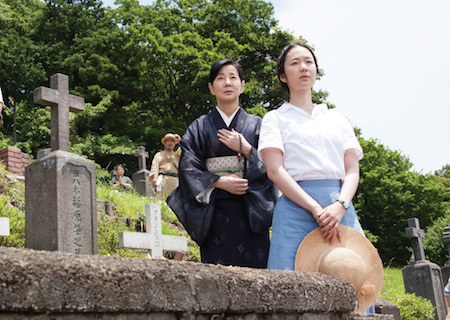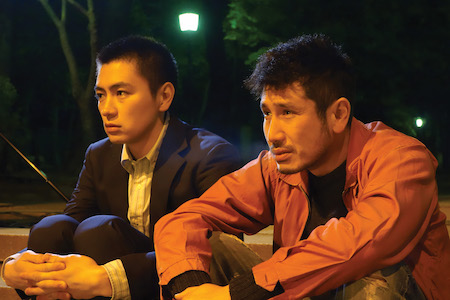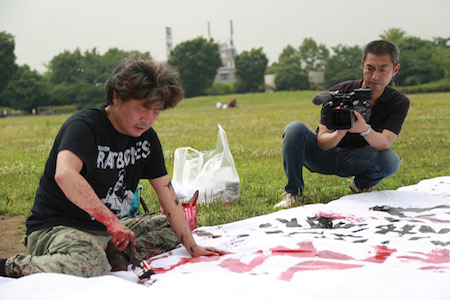Japan Cuts, North America’s largest festival of contemporary Japanese film, held annually at New York’s Japan Society, celebrated its 10th anniversary this year. Ever since its origins in 2007, this essential festival celebrated the multivalent richness and diversity to be found in current Japanese filmmaking. This edition saw the festival stepping up its game considerably, offering an especially eclectic and challenging selection, encompassing box-office hits, independent films, documentaries, experimental films, and a few classic works. Even when some of the films failed to completely deliver on their artistic promises, they did little to dispel the festival’s fun and lively vibe, with major filmmaker and star appearances.
The opening night film, Shuichi Okita’s Mohican Comes Home, directly invokes with its title and scenario Keisuke Kinoshita’s 1951 classic Carmen Comes Home, Japan’s first color feature film. Similarly to Hideko Takamine’s title character in that earlier film, Eikichi (Ryuhei Matsuda), the titular “Mohican”—so named because of the outsize Mohawk haircut he sports throughout— returns to his hometown after trying to make it in the big city. In Tokyo, he fronted a death metal band who decidedly failed to set the city on fire. What’s more, he’s knocked up his girlfriend, Yuka (Atsuko Maeda), which is a problem since Eikichi has no actual job to speak of; Yuka has been the money earner of the couple. Eikichi decides to go back home to his island home in Hiroshima, where he hasn’t visited for several years, to announce his impending fatherhood and his intentions to marry Yuka.
Although the first reaction of Eikichi’s dad, Osamu (Akira Emoto), is to chase his son around the room and try to smack him silly, Osamu soon comes around with lightning speed, throwing a grand celebration for his son’s marriage and the grandson on the way. However, Osamu collapses during the party and is later diagnosed with advanced lung cancer. Thereafter, the prodigal son spearheads the family’s efforts to comfort Osamu and help him fulfill long-cherished wishes.
In other films, this would be a turn toward maudlin melodrama; that’s not the case here. Okita takes a different and more enjoyable tack, which is that of grand farce, culminating in the wackiest wedding/funeral you’ll ever see. Okita’s approach is hilarious yet not completely lighthearted about the issues of death and generational conflict it tackles, and always heartfelt and warmly human.
Something very much the opposite of humanity is offered by Eiji Uchida’s odious Lowlife Love, a film much more notable for its relentless misogyny and general misanthropy than for anything it has to say about the filmmaking process. Its exceedingly unpleasant protagonist is Tetsuo (Kiyohiko Shibukawa), a filmmaker who made one film years ago, but he has now become a bitter loser now involved with porn shoots and running an “acting workshop” that is little more than an avenue for trying to sleep with naïve aspiring actresses. When Tetsuo runs into two ingénues—an actress and a screenwriter—who, probably unlike Tetsuo, show signs of having some actual talent, Tetsuo schemes to piggyback off them to finagle his way back into legit moviemaking.
No doubt Lowlife Love reflects in some fashion some of the unsavory realities of Japan’s low-budget filmmaking sector and the film industry as a whole, but its woeful inability to treat its female characters as anything more than victims/manipulators who unquestioningly go along with the patriarchal, rape-friendly behavior of the guys who run everything leaves a terrible taste that lingers long afterward.
Happily, the festival offered many cinematic palate cleansers for that distasteful film. One of the very best was Mipo O’s extraordinary Being Good, based on Hatsue Nakawaki’s omnibus novel. O’s film deals with difficult— and sometimes difficult to watch—subject matter, such as the generational cycles of abuse, the difficulties of educating children, autism, and dementia, with a moving sense of visual poetry and a generous view of humanity. O’s patient camera eye, which often makes mesmerizing use of long takes, refuses to divide its characters into neat, superficial categories.
Even its most initially unsympathetic character, the abusive mother played by Machiko Ono (in one of her strongest performances), is revealed as having her own history of personal abuse, which, if not excusing her actions, gives us a much more nuanced understanding of her character. This sort of patient understanding, and the film’s affirmation of everyone’s need to be praised and to feel as if they are cared for by others, is what makes Being Good more than just a beautiful work of art (which it is) but a wonderful gift from its creator to the audience.
Central to Japan Cuts were three films by and about the director Sion Sono. Scheduling conflicts unfortunately prevented him from attending the festival in person as originally planned, but he was very well represented on screen.
In one scene of The Sion Sono, a documentary by Arata Oshima (son of the late iconoclastic director Nagisa Oshima), its subject remarks at a press conference that his filmmaking philosophy is “quantity over quality.” “I keep making things,” he says, “and one of them might turn out to be good.” Indeed, the prolific nature of Sono’s recent output—six features in the past year—would seem to bear this out. Sono is not only notable for his large filmography but the way he has of late played contradictory roles: that of film festival darling and box office hitmaker, of being both maverick and mainstream. The Sion Sono delves deeply into his creative process, and he turns out to be a much more reflective person than one would expect from the maker of such wild, darkly violent films such as Suicide Club, Love Exposure, and Cold Fish.
The Sion Sono partly followed Sono during the making of his recent feature The Whispering Star, which screened at Japan Cuts. This stands out as an anomaly in Sono’s work, the most tonally quiet and serene he’s ever been. It’s also a very personal and long-gestating film—Sono wrote the script 20 years ago— that references Japan’s 2011 nuclear disaster, as much of it was filmed in the evacuated zones of Fukushima, the site of the meltdown.
The Whispering Star’s scenario makes use of these stark, deserted landscapes to sketch a postapocalyptic universe, with humankind dying out, not with a bang but a whimper, as T.S. Eliot would have put it. Eighty percent of the population are now not human but lifelike androids, such as the main character, Yoko Suzuki (Megumi Kagurazaka, Sono’s wife and frequent star), who travels the universe in a spaceship, which is essentially a moving house fitted with rocket boosters.
Yoko is an intergalactic delivery woman, transporting packages to people on dying planets, the recipients of whom often wait many years for their deliveries. In between, Yoko tends to mundane tasks with her only companion, a talking navigational system that looks like an old ham radio.
The Whispering Star boasts gorgeous black-and-white cinematography and an appealingly lo-fi production design; Yoko runs on AA batteries, and she records her thoughts on a reel-to-reel tape recorder. There are wry jokes throughout, such as day-of-the-week title cards that prove to be absurd in a universe where normal earthbound time no longer has any meaning. Despite these points of interest, however, its obsessively repetitive nature eventually becomes rather tedious, a mood which is belatedly, and only partially leavened, by a beautiful, poignant late scene. But if the aridly minimalist and numbing repetition of The Whispering Star is Sono’s idea of Serious Art, then I much prefer the grand excesses of such films as Why Don’t You Play In Hell?, Love Exposure, or Himizu.
A much more natural fit for Sono’s talents and sensibilities is Love & Peace, which, like The Whispering Star, had a two-decade long gestation in its creator’s imagination. Also like that film, Love & Peace invokes Japan’s nuclear-based fears as well as the nuclear destruction of the country’s past. However, in stark contrast to the hushed solemnity of The Whispering Star, Love & Peace is a bright, colorful pop object, combining elements of kiddie flicks, musicals, and kaiju eiga (monster movies).
Our hero is Kyo (Hiroki Hasegawa), a hapless milquetoast harried by constant bullying by his coworkers and fellow straphangers on the subway. The only person who shows him anything resembling kindness is his work colleague, Yoko (Kumiko Aso), an equally awkward woman who nevertheless seems to be better able to fit in at work.
Kyo’s only friend in the world is a pet turtle he buys from a street vendor. He names it Pikadon, which in Japanese refers to the atomic blasts of World War II. Pikadon becomes Kyo’s constant companion, but when he’s caught with the turtle at work, he’s so brutally mocked that he feels compelled to flush Pikadon down the toilet, an act that he instantly regrets.
Pikadon’s travels down the sewer leads him to a magical underground lair, whose caretaker is a kindly wino, who cares for other abandoned pets, as well as discarded stuffed animals, dolls and other toys. He gives them magical candy that gives them the power of speech. Pikadon is given a magical candy, too, but instead of allowing him to speak, it instead grants the turtle a wish, which is to make Kyo’s long-held dreams come true, as the turtle itself begins to grow to ever larger proportions.
Kyo’s long abandoned dream was to be a famous rock star. With Pikadon’s remote help as a sort of reptilian songwriting Cyrano de Bergerac, Kyo is discovered by music executives and gains hit songs and massive popularity. Meanwhile, Pikadon grows larger and larger.
The spectacle of Kyo’s maladroit antics and awkward, sad-sack loser-dom makes for some initially grating opening scenes. This eventually gives way, though, to a much more enjoyably wacky parable involving young people’s forgetting of the past, present-day nuclear disaster anxieties, and a pro-environmental sustainability message that all humans, animals, and objects have value.
Actor Lily Franky, recipient of the festival’s Cut Above Award for Outstanding Performance in Film, has been quite busy in the past several years, appearing in three films in this year’s fest, including Hitoshi One’s Bakuman and Ryosuke Hashiguchi’s Three Stories of Love.
Usually an ensemble and supporting actor, Franky takes on a rare leading role in Yoshifumi Tsubota’s second feature The Shell Collector. Based on Anthony Doerr’s eponymous short story, the film shifts locales from the Kenya of the original to Okinawa.
Franky plays a blind professor who has largely isolated himself from the rest of society on this island, collecting various species of marine life, removing their shells for study and philosophical contemplation. His carefully constructed solitude is upended by the arrival of Izumi (Shinobu Terajima), a woman who washes up one day on the shore. Formerly a painter, Izumi has been afflicted with a paralysis-causing virus, an epidemic which has been spreading throughout the country. This virus has frozen her hand, preventing her from practicing her art and sending her into a suicidal depression.
One night, Izumi is stung by a poisonous cone snail caught by the professor. It nearly kills her, but the snail itself miraculously heals her hand. She excitedly begins painting again, creating a large seashell mural. Izumi also offers herself to the professor sexually and begs him to let her be stung again. He resolutely rejects her advances and pleas, and she eventually leaves the island.
Later, the island headman hears about this mysterious healing agent the professor has stumbled upon and strong-arms him into using it to heal his ailing shaman daughter. Matters are further complicated by the arrival of the professor’s long-estranged son, who heads an activist NGO and brings a colony of the afflicted along with him.
The Shell Collector gets maximum visual mileage out of its picturesque Okinawa locations, providing stunning seaside vistas and haunting images of underwater sea life and of the professor in even deeper isolation under the sea. However, the vague, airy mysticism of the proceedings never coheres into anything substantial. There are thematic allusions to humans’ destructive footprint on the natural world and the U.S. military’s presence in Okinawa, long a source of tensions and protest, but the film fails to communicate any compelling statements on either of these issues. The result is a viewing experience so diffuse that any lasting impressions evaporate as soon as it’s over.
Japan’s 2011 nuclear and natural disasters continue to be a major subject in contemporary Japanese films, and this is reflected in some of this year’s selections. While this is more obliquely evoked in the settings of The Whispering Star, two other films deal with nuclear disasters more directly.
Koji Fukada’s Sayonara, based on a stage play by Oriza Hirata, doesn’t mention the Fukushima meltdown by name, but the apocalyptic mood of nuclear disaster permeates the film, which follows Tanya (Bryerly Long), a South African raised in rural Japan, and her android companion and caregiver, Leona. Sayonara’s major point of interest is that Leona is played by an actual android named Geminoid F, the first co-starring role by a robot in a feature film.
While other characters figure here, this is mostly a two-hander centering on Tanya and Leona. They spend long hours with each other, Tanya lounging on her couch, and Leona reading her poetry in Japanese, French, and German, as the terminally ill Tanya and the wheelchair-bound Leona wait, probably in vain, to be chosen for departure by the government’s evacuation program.
Sayonara takes a different stylistic tack than the director’s previous Rohmer-esque ensembles, such as Hospitalité and Au Revoir L’été; here a hushed, depressive mood floats through this exceedingly slow-paced film. While there is some beautifully delicate, golden-hued cinematography and some interesting questions raised about what it means to be human in the midst of impending mass death, the film’s oppressive dreariness unfortunately smothers it all and mutes its impact.
Yoji Yamada’s Nagasaki: Memories of My Son delves into the past: the nuclear bombing of Nagasaki, a tragic historical event that has obvious relevance to the present. The film opens by visually evoking the destruction and then shifts to an intimate family drama not dissimilar to works that would have been made closer to the 1940s time period. The action centers on Nobuko (Sayuri Yoshinaga), a midwife who lost her son Koji (Kazuya Ninomiya) in the bombing; the school he was attending was obliterated in the attack. Three years after the bombing, Nobuko begins to be visited by Koji’s ghost, who visits her frequently to keep her company and reminisce about the past. Nobuko is also visited by Koji’s fiancée Machiko (Haru Kuroki), who refuses to let go of Koji’s memory or to consider finding another man to marry.
Though there is much poignancy in this scenario, enhanced by Ryuichi Sakamoto’s appropriately elegiac score, there is also some warm, gentle humor. Veteran director Yamada, best known for the long-running series of films featuring the beloved character Tora-san, creates a wonderful work that is beautifully acted, and which is old-fashioned in the very best sense, evoking the past masters of Japanese cinema, among whom Yamada can very much be included as one.



















Leave A Comment